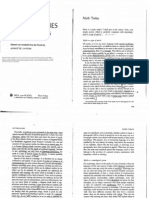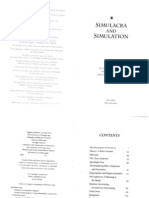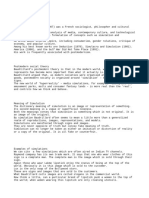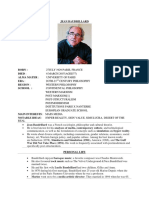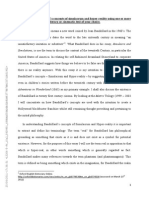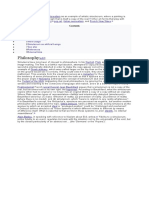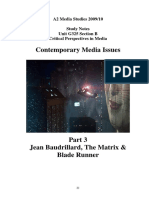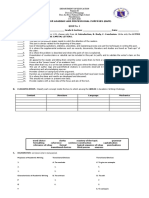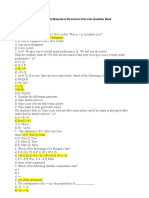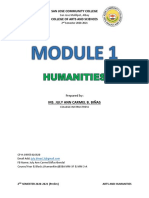Simulacra and Simulation (French: Simulacres et Simulation) is a
1981philosophical treatise by Jean Baudrillard seeking to interrogate the
relationship among reality, symbols, and society.
Simulacra are copies that depict things that either had no reality to begin with,
or that no longer have an original.
[1]
Simulation is the imitation of the operation
of a real-world process or system over time.
[2]
...The simulacrum is never that which conceals the truthit is the truth which
conceals that there is none. The simulacrum is true.
[3]
Simulacra and Simulation is most known for its discussion of symbols, signs,
and how they relate to contemporaneity (simultaneous existences).
Baudrillard claims that our current society has replaced all reality and meaning
with symbols andsigns, and that human experience is of a simulation of
reality. Moreover, these simulacra are not merely mediations of reality, nor
even deceptive mediations of reality; they are not based in a reality nor do
they hide a reality, they simply hide that anything like reality is relevant to our
current understanding of our lives. The simulacra that Baudrillard refers to are
the significations and symbolism of cultureand media that construct perceived
reality, the acquired understanding by which our lives and shared existence is
and are rendered legible; Baudrillard believed that society has become so
saturated with these simulacra and our lives so saturated with the constructs
of society that all meaning was being rendered meaningless by being infinitely
mutable. Baudrillard called this phenomenon the "precession of simulacra".
"Simulacra and Simulation" breaks the sign-order into 4 stages:
1. The first stage is a faithful image/copy, where we believe, and it may
even be correct, that a sign is a "reflection of a profound reality" (pg 6),
this is a good appearance, in what Baudrillard called "the sacramental
order".
2. The second stage is perversion of reality, this is where we come to
believe the sign to be an unfaithful copy, which "masks and denatures"
reality as an "evil appearanceit is of the order of maleficence". Here,
signs and images do not faithfully reveal reality to us, but can hint at the
existence of an obscure reality which the sign itself is incapable of
encapsulating.
3. The third stage masks the absence of a profound reality, where the
simulacrum pretends to be a faithful copy, but it is a copy with no
original. Signs and images claim to represent something real, but no
representation is taking place and arbitrary images are merely
suggested as things which they have no relationship to. Baudrillard
calls this the "order of sorcery", a regime of semantic algebra where all
human meaning is conjured artificially to appear as a reference to the
(increasingly) hermetic truth.
4. The fourth stage is pure simulation, in which the simulacrum has no
relationship to any reality whatsoever. Here, signs merely reflect other
signs and any claim to reality on the part of images or signs is only of
the order of other such claims. This is a regime of total equivalency,
where cultural products need no longer even pretend to be real in a
nave sense, because the experiences of consumers' lives are so
predominantly artificial that even claims to reality are expected to be
phrased in artificial, "hyperreal" terms. Any nave pretension to reality
as such is perceived as bereft of critical self-awareness, and thus as
oversentimental.
Simulacra and Simulation identifies three types of simulacra and identifies
each with a historical period:
1. First order, associated with the premodern period, where representation
is clearly an artificial placemarker for the real item. The uniqueness of
objects and situations marks them as irreproducibly real and
signification obviously gropes towards this reality.
2. Second order, associated with the modernity of the Industrial
Revolution, where distinctions between representation and reality break
down due to the proliferation of mass-reproducible copies of items,
turning them into commodities. The commodity's ability to imitate reality
threatens to replace the authority of the original version, because the
copy is just as "real" as its prototype.
3. Third order, associated with the postmodernity of Late Capitalism,
where the simulacrum precedes the original and the distinction between
reality and representation vanishes. There is only the simulacrum, and
originality becomes a totally meaningless concept.
[4]
Baudrillard theorizes that the lack of distinctions between reality and simulacra
originates in several phenomena:
[5]
1. Contemporary media including television, film, print, and the Internet,
which are responsible for blurring the line between products that are
needed (in order to live a life) and products for which a need is created
by commercial images.
2. Exchange value, in which the value of goods is based on money
(literally denominated fiat currency) rather than usefulness, and
moreover usefulness comes to be quantified and defined in monetary
terms in order to assist exchange.
3. Multinational capitalism, which separates produced goods from the
plants, minerals and other original materials and the processes
(including the people and their cultural context) used to create them.
4. Urbanization, which separates humans from the nonhuman world, and
re-centres culture around productive throughputsystems so large they
cause alienation.
5. Language and ideology, in which language increasingly becomes
caught up in the production of power relations between social groups,
especially when powerful groups institute themselves at least partly in
monetary terms.
A specific analogy that Baudrillard uses is a fable derived from "On Exactitude
in Science" by Jorge Luis Borges. In it, a great Empire created a map that was
so detailed it was as large as the Empire itself. The actual map was expanded
and destroyed as the Empire itself conquered or lost territory. When the
Empire crumbled, all that was left was the map. In Baudrillard's rendition, it is
conversely the map that people live in, the simulation of reality where the
people of Empire spend their lives ensuring their place in the representation is
properly circumscribed and detailed by the map-makers; conversely, it is
reality that is crumbling away from disuse.
The transition from signs which dissimulate something to signs which
dissimulate that there is nothing, marks the decisive turning point. The
first implies a theology of truth and secrecy (to which the notion of
ideology still belongs). The second inaugurates an age of simulacra and
simulation, in which there is no longer any God to recognize his own,
nor any last judgment to separate truth from false, the real from its
artificial resurrection, since everything is already dead and risen in
advance.
[4]
It is important to note that when Baudrillard refers to the "precession of
simulacra" in Simulacra and Simulation, he is referring to the way
simulacra have come to precede the real in the sense mentioned above,
rather than to any succession of historical phases of the image. Referring
to "On Exactitude in Science", he argued that just as for contemporary
society the simulated copy had superseded the original object, so, too, the
map had come to precede the geographic territory (c.f. Mapterritory
relation), e.g. the first Gulf War (which Baudrillard later used as an object
demonstration): the image of war preceded real war. War comes not when
it is made by sovereign against sovereign (not when killing for attritive and
strategic neutralisation purposes is authorised; nor even, properly spoken,
when shots are fired); rather, war comes when society is generally
convinced that it is coming.
Henceforth, it is the map that precedes the territoryprecession of
simulacrait is the map that engenders the territory and if we were to
revive the fable today, it would be the territory whose shreds are slowly
rotting across the map.
[4]
See also[edit]





